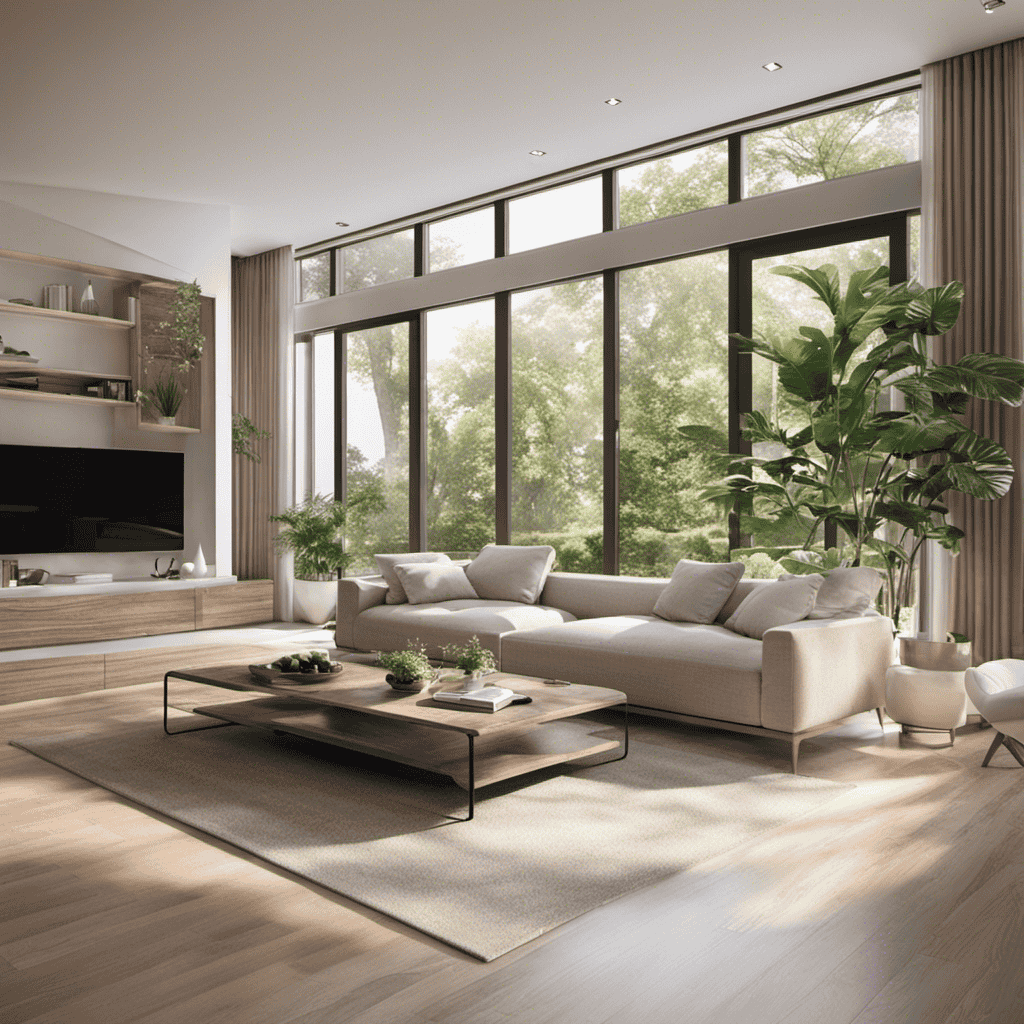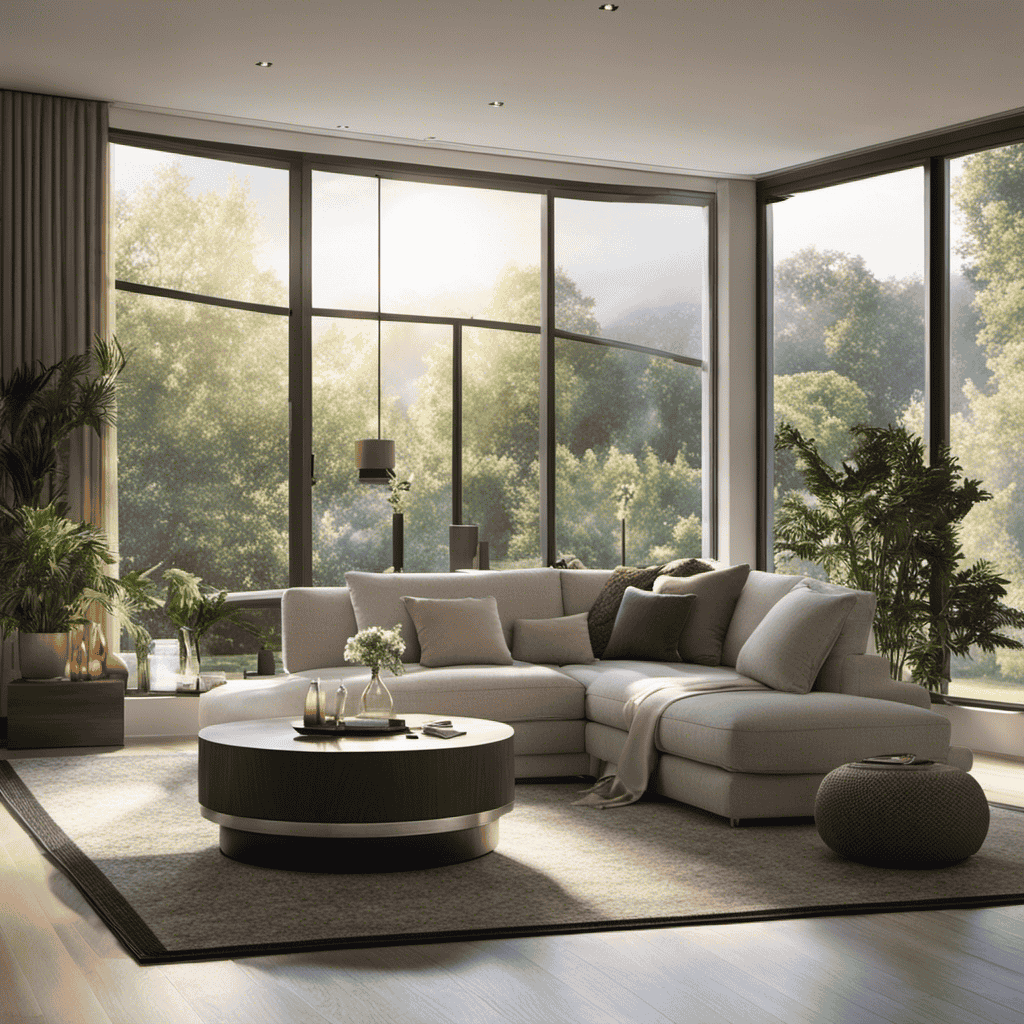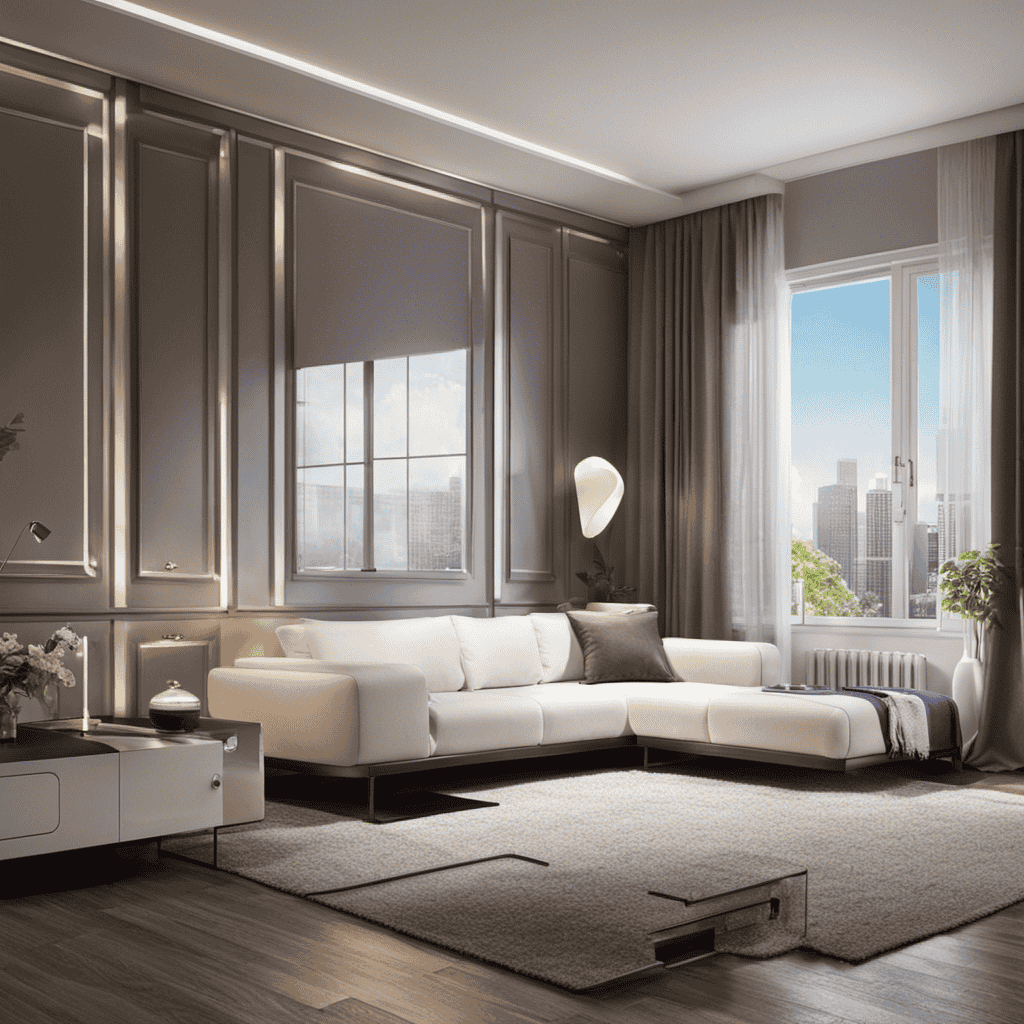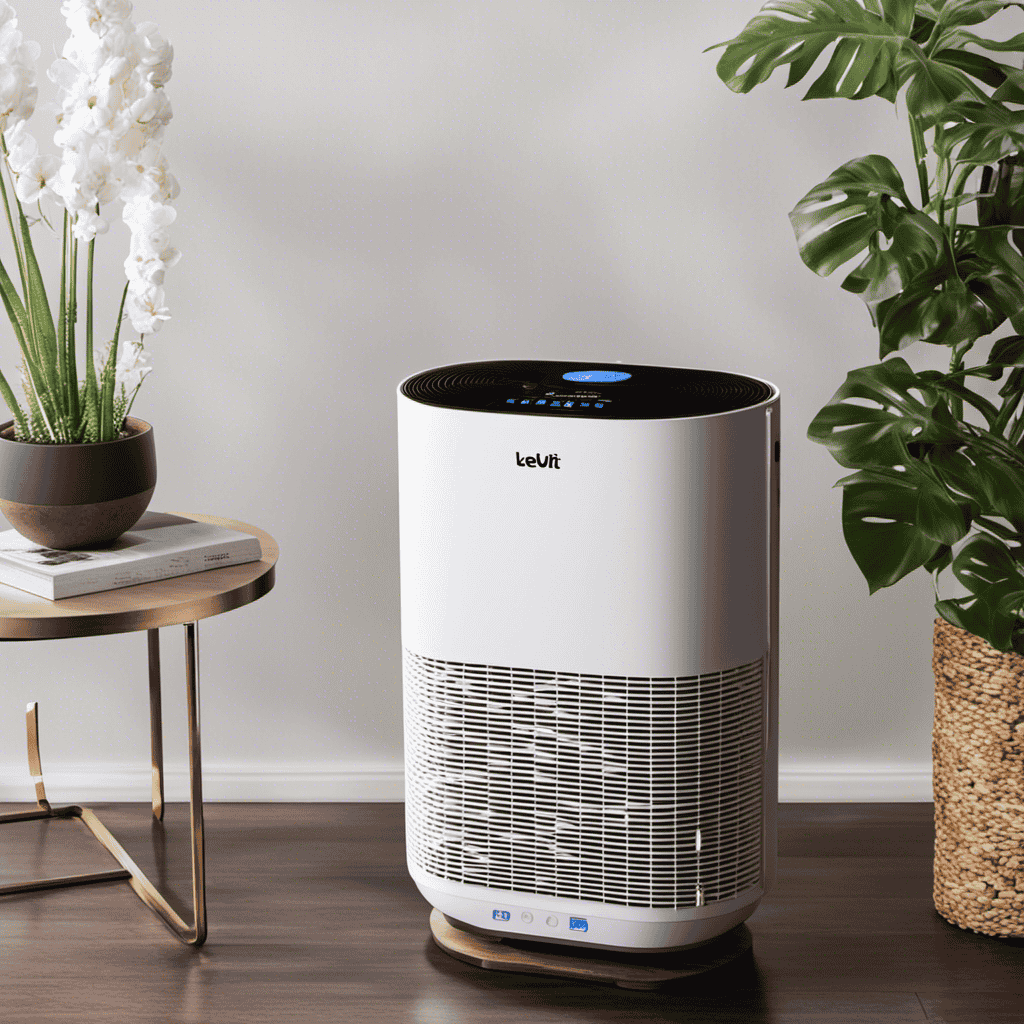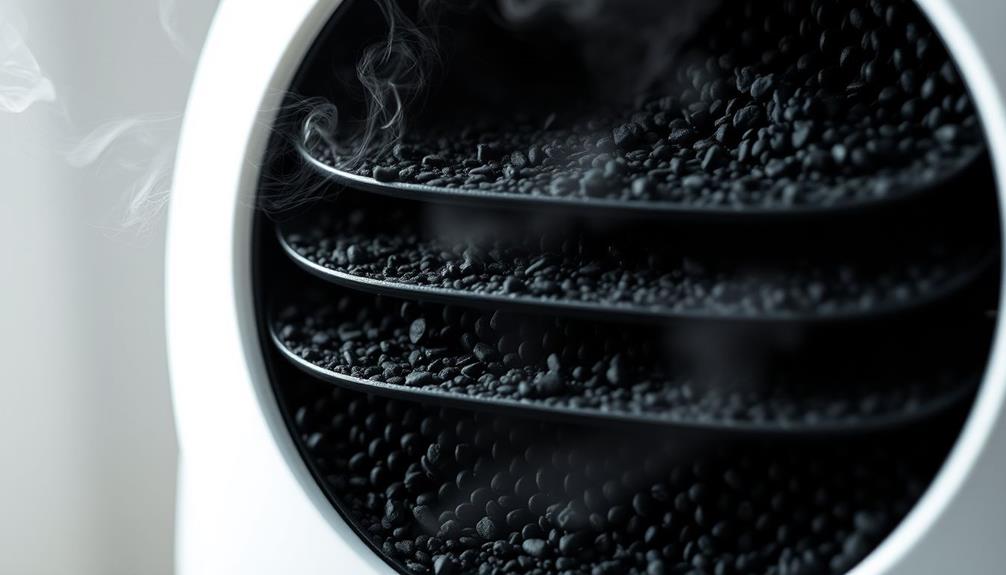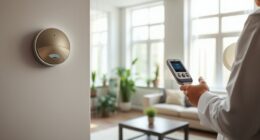Just like a breath of fresh air, an air purifier guarantees to detoxify the surroundings and enhance indoor air quality. However, how long does it typically take for an air purifier to show results?
In this article, I will delve into the functionality of air purifiers, explore the factors that affect their effectiveness, and provide a recommended timeframe for visible results.
By monitoring air quality improvement and adjusting our expectations, we can maximize the benefits of our air purifiers.
Let’s dive in and uncover the secrets to quicker, cleaner air.
Key Takeaways
- Factors such as room size, air quality, type of filter, maintenance, build quality, airflow, placement, and pollutant presence all affect the effectiveness of an air purifier.
- When selecting an air purifier, consider the room size, specific pollutants, clean air delivery rate (CADR), filter type, and longevity for long-term effectiveness.
- Visible results from using an air purifier can be expected within a week, including a reduction in airborne allergens, improvement in respiratory symptoms, and a decrease in unpleasant odors.
- Monitoring and testing indoor air quality parameters, such as particulate matter (PM) levels, volatile organic compounds (VOCs), and carbon dioxide (CO2) levels, can help assess the air purifier’s effectiveness over time.
Understanding Air Purifier Functionality
Air purifiers can help improve indoor air quality by removing pollutants such as dust, pet dander, and pollen. Understanding how air purifiers function is essential in choosing the right one for your needs. Factors affecting air purifier lifespan include the quality of the filters used, maintenance, and the air purifier’s overall build quality. It’s important to consider these factors when purchasing an air purifier to ensure its longevity.
Additionally, selecting the right air purifier for your needs involves considering the size of the room, the specific pollutants you want to target, and the desired clean air delivery rate (CADR). By taking these factors into account, you can choose an air purifier that will effectively improve your indoor air quality.
Now, let’s delve into the factors affecting air purifier effectiveness.
Factors Affecting Air Purifier Effectiveness
Factors such as room size, air quality, and the type of filter used can impact how quickly an air purifier starts to take effect.
-
Room size: The larger the room, the longer it may take for the air purifier to work effectively. This is because the air purifier needs time to circulate the air and remove pollutants.
-
Air quality: If the air quality is severely poor, it may take longer for the air purifier to improve the air. High levels of pollutants, such as smoke or dust, can overwhelm the purifier’s capacity and slow down the process.
-
Type of filter: Different air purifiers use different types of filters, such as HEPA or activated carbon filters. The effectiveness of these filters can vary, impacting the speed at which the purifier cleans the air.
Understanding these factors can help determine how long it may take for an air purifier to work effectively. Considering room size, air quality, and filter type is essential in maximizing the performance of an air purifier and ensuring clean and healthy air in your space.
Recommended Timeframe for Air Purifier to Show Results
In my research on air purifiers, I’ve found that the timeframe for noticing initial improvements can vary depending on several factors.
One key factor is the size of the room and the air purifier’s coverage area. Additionally, the level of air pollution and the type of contaminants present can also affect the effectiveness of an air purifier.
Understanding these factors can help determine the recommended timeframe for an air purifier to show results and provide cleaner air.
Initial Noticeable Improvements
Within a week of using the air purifier, you’ll start noticing improvements in the air quality. This is due to the initial benefits that the air purifier provides. Here are some noticeable changes that you can expect:
- Reduction in airborne allergens such as dust, pollen, and pet dander.
- Decrease in unpleasant odors caused by cooking, smoking, or pets.
- Improvement in respiratory symptoms such as sneezing, coughing, and congestion.
Research shows that air purifiers work by filtering out pollutants and contaminants from the air, leading to cleaner and healthier indoor environments. The speed at which you’ll experience these changes may vary depending on factors like room size, air quality, and the specific air purifier model.
However, within a week, you should start seeing the initial benefits of using an air purifier, making a noticeable difference in the air you breathe.
Factors Affecting Effectiveness
To maximize the effectiveness of your air purifier, it’s important to consider the size of the room it will be placed in. Factors such as room size, airflow, and optimal placement can greatly affect the speed at which your air purifier works.
When determining the optimal placement of your air purifier, it’s crucial to consider the following factors:
| Factor | Description |
|---|---|
| Room Size | Larger rooms may require a more powerful air purifier to effectively clean the air. |
| Airflow | Ensuring proper airflow within the room can help the air purifier work more efficiently. |
| Placement | Placing the air purifier in a central location within the room can help it capture more airborne particles. |
Monitoring Air Quality Improvement With an Air Purifier
When monitoring air quality improvement with an air purifier, there are several key points to consider.
Firstly, it is important to understand the immediate changes that can be observed after using an air purifier, such as a reduction in airborne pollutants and odors.
Secondly, tracking the long-term improvements is crucial to assess the overall effectiveness of the air purifier in maintaining clean air over time.
Lastly, there are various factors that can affect the effectiveness of an air purifier, such as room size, filter type, and the presence of specific pollutants. Understanding these factors can help in making informed decisions about air purifier usage.
Immediate Air Quality Changes
You’ll notice immediate changes in the air quality once you turn on the air purifier. It is important to understand the immediate impact of an air purifier on the air quality in order to effectively measure changes. Here are three key observations to consider:
-
Reduction in airborne particles: When the air purifier is activated, it immediately starts capturing and filtering out airborne particles such as dust, pollen, and pet dander. This leads to a noticeable decrease in the number of particles present in the air.
-
Odor elimination: Air purifiers equipped with activated carbon filters can effectively eliminate unpleasant odors caused by cooking, pets, or smoke. As soon as the purifier starts running, you’ll notice a significant improvement in the odor quality.
-
Improved breathing experience: By removing allergens and pollutants from the air, air purifiers can provide relief to individuals suffering from respiratory conditions or allergies. You’ll experience easier and cleaner breathing almost instantly.
Tracking Long-Term Improvements
In order to determine the effectiveness of an air purifier in the long term, tracking progress and measuring its impact on air quality is crucial. This can be done through regular monitoring and testing of indoor air quality parameters, such as particulate matter (PM) levels, volatile organic compounds (VOCs), and carbon dioxide (CO2) levels. By comparing the measurements before and after the installation of an air purifier, one can assess its effectiveness in improving the overall air quality.
To emphasize the importance of tracking progress, I have included a table below that highlights the different parameters that can be measured and monitored:
| Parameters | Description |
|---|---|
| Particulate Matter (PM) | Measures the concentration of small particles in the air, which includes dust, pollen, pet dander, and other allergens. |
| Volatile Organic Compounds (VOCs) | Measures the presence of harmful chemicals emitted from cleaning products, furniture, and building materials. |
| Carbon Dioxide (CO2) | Measures the level of CO2 in the air, which can indicate poor ventilation and high occupancy levels. |
Factors Affecting Effectiveness
To maximize the effectiveness of an air purifier, it’s important to consider factors such as the size of the room and the presence of potential air pollutants. The purification speed can be influenced by various factors, including the following:
-
Air Quality: The initial air quality in the room determines how much work the purifier needs to do. Higher levels of pollutants will require a longer purification time.
-
Room Size: The size of the room plays a crucial role in the effectiveness of an air purifier. A larger room will require more time to circulate and purify the air thoroughly.
-
Airflow: The airflow in the room affects the distribution of purified air. Proper ventilation and positioning of the purifier can help optimize its performance.
Considering these factors will help ensure that your air purifier works efficiently and effectively, providing you with cleaner and healthier air to breathe.
Adjusting Expectations: Realistic Timelines for Air Purifier Performance
Don’t expect immediate results when using an air purifier; it may take some time to see noticeable improvements in air quality.
It’s important to have realistic expectations when it comes to the performance of air purifiers. One common misconception is that an air purifier will instantly clean the air as soon as it is turned on. However, the reality is that air purifiers work by continuously filtering the air over time, gradually removing pollutants and improving air quality.
The amount of time it takes to see significant results can vary depending on factors such as the size of the room, the level of pollution, and the efficiency of the air purifier. It is recommended to give the air purifier a few days to a few weeks to make a noticeable difference in the air quality of your space.
Enhancing Air Purifier Efficiency for Quicker Results
Using an air purifier consistently and optimizing its settings can help expedite improvements in air quality. To maximize effectiveness and optimize performance, consider the following strategies:
-
Choose the right filter: Select a filter that suits your specific needs, such as HEPA filters for allergens or activated carbon filters for odors and chemicals.
-
Adjust fan speed: Increasing the fan speed can enhance the air circulation and filtration rate, leading to quicker purification.
-
Regular maintenance: Clean or replace the filter as recommended by the manufacturer to ensure optimal performance.
Research shows that by implementing these measures, air purifiers can work more efficiently and effectively. However, it’s important to note that the time it takes for an air purifier to fully improve air quality depends on various factors, including room size, air pollution levels, and the initial air quality.
Tips for Maximizing the Benefits of Your Air Purifier
Regularly cleaning and replacing the filters in my air purifier can help it perform more efficiently. Research shows that clean filters allow the air purifier to effectively capture and remove airborne pollutants, such as dust, pollen, and pet dander.
By following best practices, I can maximize the benefits of my air purifier and ensure it works at its best. One of the key practices is to clean or replace the filters according to the manufacturer’s instructions. This will prevent clogging and maintain optimal airflow.
Additionally, placing the air purifier in a central location within the room and keeping doors and windows closed can help maximize its efficiency by preventing outside pollutants from entering.
How Long Does it Take for an Air Purifier to Have an Effect?
Leaving air purifier on can vary in how long it takes to see an effect. For smaller rooms, you may notice a difference within a few hours. However, for larger spaces, it could take a day or two. Consistently leaving air purifier on is key to maintaining clean air.
Frequently Asked Questions
Can an Air Purifier Effectively Remove All Types of Pollutants From the Air?
Yes, an air purifier can effectively remove various types of pollutants from the air. However, it has limitations as it may not eliminate all pollutants completely. Regular maintenance and choosing the right type of purifier are crucial for optimal effectiveness.
Do Air Purifiers Produce Any Harmful Byproducts or Emissions?
Air purifiers can produce harmful byproducts such as ozone and volatile organic compounds. These emissions can pose safety concerns and impact indoor air quality. It is important to choose an air purifier with low emissions to ensure a healthy environment.
Can an Air Purifier Completely Eliminate Allergens Like Pollen and Pet Dander From the Air?
Yes, an air purifier can effectively eliminate allergens like pollen and pet dander from the air. Regular air purifier maintenance and choosing the right air purifier are crucial for optimal performance.
How Often Should the Filters in an Air Purifier Be Replaced?
I replace my air purifier filters every 3-6 months, depending on usage. Signs of a dirty filter include reduced airflow and a musty smell. Regular filter replacements ensure optimal performance and clean air.
Should I Run My Air Purifier Continuously or Only When I Am in the Room?
Running an air purifier continuously offers the benefit of consistent air purification throughout the day, ensuring clean air at all times. However, running it only when in the room may have drawbacks as it won’t purify the air in other areas of the house.
Conclusion
In conclusion, it is crucial to understand the functionality of air purifiers in order to determine their effectiveness. Factors such as room size, air quality, and the type of pollutants present can influence how quickly the purifier will show results. By monitoring the improvement in air quality with an air purifier and adjusting our expectations accordingly, we can have realistic timelines for its performance.
Additionally, it is important to enhance the efficiency of the purifier through regular maintenance and proper placement. This can lead to quicker results and maximize the benefits of the air purifier. By following these tips, we can create a cleaner and healthier environment.

